|
Articles
3 Mar 2021 How the Inventor of CATIA Became the Founder of Dassault SystèmesThis July marks the 40th anniversary of the founding of Dassault Systèmes. On the eve of this anniversary, we turned to Francis Bernard, co-founder of the company, with a request to talk about his life path, which is associated both with the emergence of the first industrial 3D CAD system CATIA and foundation of a market leader in engineering software.
Questions for the interview were formulated by members of LEDAS who have been involved in the company's 12-year long cooperation with Dassault Systèmes and were proud to welcome Francis Bernard during his visits to the international isicad forums in Novosibirsk.
1. You spent your first twelve years in Vietnam. Do you recall your time there? Did that period impact your later life, such as your habits, attitude towards Asia including China and Russia? Perhaps you had Vietnamese friends?
I was born in Hanoi in 1940, then still part of French Indochina, today Vietnam. My father was an engineer in the coalmines of northern Vietnam. I attended primary school in Haiphong and Dalat. In 1952, my family returned to France and settled in Paris.
Yes, I still keep some memories of that time. I was a young child, speaking some Vietnamese with young local friends in the street. I learned that humanity is made of people with different colors, languages and cultures.
2. After your family came back to France, did you have any problems adjusting to the different culture?
No. Vietnam was a French colony and I lived with my family in a French environment. Even today, the buildings in Hanoi and Haïphong look French. In 2013
I went to North Vietnam to look where I had lived in 1950 when I was ten years old. Our house in Haïphong was still here, my elementary school as well, with minor modifications And in the local university, they now teach CATIA!
3. What and who influenced your interest in technology, in particular aerospace engineering?
I was fascinated by airplanes. When I was 12-17 years old, I spent most of my free time constructing aircraft models, including one with a radio transmitter that I developed by myself with tube amps, because there were no transistors yet, and then flew them in a park in nearby Paris.
As a young student, I worked very hard to enter Supaero, the top aerospace engineering university in France. At Supaero I had the opportunity to fly as a pilot in private airplanes. And I discovered one of the first computers of this time, the CAB 500, which was as big as a wardrobe but a lot less powerful than pocket calculators that you today buy for $10 in the supermarket.
4. Was joining Dassault Aviation (DA) accidental? Did you have any such intention due to contacts during your Superavio years? Maybe your military service influenced it?
Joining DA was not accidental. DA was very prestigious because of its Mirage fighters at the time of the Cold War. The technology there was quite sophisticated and the salary quite attractive. I had already a pre-employment contract with DA while I was still a student at Supaero, receiving a monthly fee for several years (including during my military service) before joining DA. So I had a legal commitment to join!
5. At first glance, your initial specialization in theoretical aerodynamics appears very different from professional software development. How did it happen that you became so quickly involved in a domain that seems rather new, given your background? Did you feel natural affinity with software development?
When I began with DA in 1967, there were no computers anywhere. It was still the time of paper, pencils, and typewriters. The two first computers, the IBM 1800, were installed by coincidence the same time that I arrived.
We began developing mathematical algorithms to calculate aerodynamic flows along wings and fuselages. We learned how to convert our mathematical language into programming language to deliver air pressure values on aircraft geometry. Of course, the first fundamental problem was to create the mathematics, then to create a software/data representation of the airplane’s shape, because it was used as input to the aerodynamics computations. Like most engineers in the world at this time (end of the 1960s), we had to learn to experiment with software development on these very early computers.
6. There is a serious difference between computational software modules that were the predecessors to CATIA, and, on the other hand, CATIA as universal CAD engine. Does it mean that you had to design a new architecture for CAD? To do that, did you invite experts in software development to assist you, or was it your own contribution, or contributions by some of your colleagues?
At the beginning, at the end of the 1960s and into the early 1970s, the only way to communicate with a computer — to create and manipulate data — was to write software in an alphanumeric language that we entered on punch cards. So, we invented a specific language to create and to store the shape of the airplane in the memory of the computer: wings were ruled surfaces between profiles defined by fifth-degree curves, and fuselages were conics evolving along fifth-degree curves.
We also invented a specific alphanumeric language to exploit the shapes: input for aerodynamics computation, sections by planes, and cutting-tool motions for numerical-control machines.
Then in the early 1970s we had the first black and white graphics terminals (first the IBM 2250, then the IBM 3250 terminal) together with a new generation of much more powerful computers (the IBM/360, then the IBM/370 mainframe). It opened up the opportunity to convert our alphanumeric language (on decks of punched cards) into a much simpler-to-use language on interactive graphic terminals.
In 1977, I decided, with the support of my management, that it was time to re-write all our software to handle the conversion. Like the first generation on punched cards, we did all the software development by ourselves, of course taking benefit of our experience with the mathematical definitions of the shapes and converting the alphanumeric language into an interactive graphical interface. At this time (end of 1970s) there were five developers in my team.
7. What is common and what is different between the development of an airplane and a CAD system?
What is common: we learned from the airplane engineers all about the shapes and optimization of the shapes of airplanes. And how to manufacture these shapes.
What is different: airplane engineers develop an airplane according to specific requests (performance, capacity, range, and so on) but we develop software as a tool to help them develop more competitive airplanes at lower prices.
8. Aside from Dassault Aviation and Boeing, what was the most significant usage of CATIA — not in terms of revenues, but in terms of the new experiences for you and your team?
My first customers, even a few months before the creation of DS in 1981, were Mercedes, BMW, and Honda — I mean the engineering divisions of these automotive companies. I developed group meetings that involved the three of them, despite them being competitors in the market. I explained and demonstrated CATIA to them, and they explained to me the automotive specifics of shape design (body engineering) as well as manufacturing. As a result, they accepted the evaluation of CATIA on their sites. My team worked with them to understand and to satisfy their requirements for CATIA.
In summary, I implemented as successful a relationship with them as I had with aircraft designers to expand CATIA to support the needs of the automotive industry.
Similar processes were implemented during the 1980s and 1990s with the industries we support, shipbuilding, equipment, consumer goods, and so on.
This is really a profile of a software developer: create an innovation of value to the customer, by mixing an understanding of each industry segment process with new IT technology.
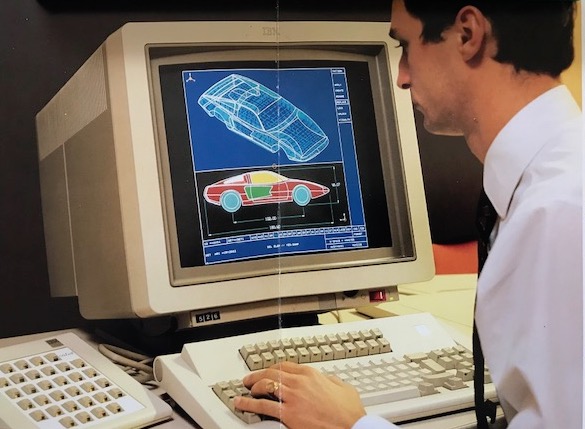
1987, CATIA
9. CATIA is 40 years old, and it seems to be the oldest CAD software still on the market, and yet it still takes the leadership position. How many more years will it live on?
I don’t know, but let me remind you the history of design:
- SKETCHES from antiquity to 19th century (5,000 years): pen and paper, written by individuals for their own purpose; for example, the sketches by Leonardo da Vinci.
- DRAWINGS from the 19th to the 20th century (150 years): pen and paper, with the standardization of drawing representations acting like a language for large teams to be able to cooperate; this was the design/manufacturing platform for the Industrial Revolution.
- 2D CAD from 1970 to 1990 (20 years): computer graphics terminals that optimized the performance of 2D drawings; this was the CADAM positioning.
- 3D from 1970 to 1980 (10 years): computers with alphanumeric languages on punched cards; they allowed the first exact 3D definition on computers.
- 3D CAD from 1980 to … (?? years): computer graphics terminals that optimize the performance of 3D design; this is the CATIA positioning.
- NEXT STEP: probably the automatic generation and exploitation of 3D shapes based on artificial intelligence, with full optimization through integration of simulation and interaction with any type of constraints.
Each step demonstrates a significant innovation in design, but does not eliminate the previous steps. Sketches, for instance, are still in use.
It is extremely difficult to predict the future in technology. Who in 1990 knew about the Internet and smartphones? Nobody!
10. CATIA was a revolution in the CAD industry by being the first 3D design system. Do you see the potential for any technology to transform engineering industry as much in the twenty-first century?
See my answer above.
11. If you could go back to the 1980s, is there anything you would like to change in CATIA to make even more successful today?
I believe that we did our best in the 1980s, according to the technology of the time. We had graphic terminals in color (the IBM 5080) only in 1985, PCs powerful enough only in 1995, and now the cloud. These developments significantly impacted CATIA by opening new opportunities to develop new applications.
12. What was the key to the success of CATIA: excellent product management? Brilliant software developers and mathematicians? Or sales people from IBM?
All three must be taken together. Only one or two would have been insufficient.
For instance, [competitor from aircraft manufacturer Lockheed] CADAM had brilliant software developers and sales people from IBM, but poor product management, so they missed 3D.
[Independently-developed] ComputerVision had brilliant software developers but poor product management. By developing their own hardware, they missed the standardization of hardware, and had no sales force as strong as the one from IBM.
[Independently-developed] Matra Datavision lacked a sales force as strong as IBM’s. They all disappeared after being acquired by other companies.
13. There is a well-known picture of a CATIA demonstration being given to Marcel Dassault. Was this episode important to further business development? Please share the impressions you had from this demonstration.
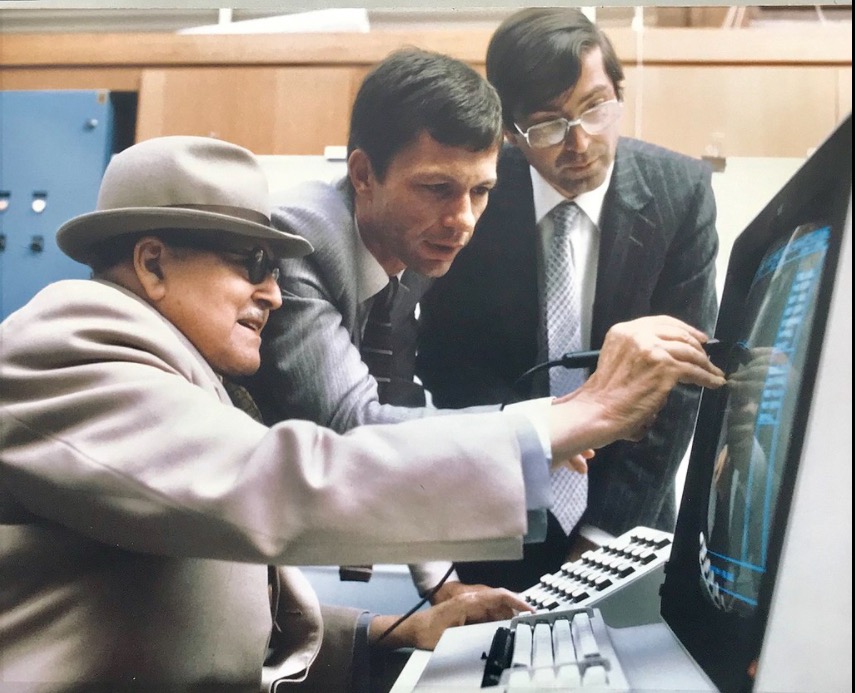
Francis Bernard and Dominique Calmels introduce Marcel Dassault to CATIA
This episode was important and at this time probably key to our future. Marcel Dassault was the extremely respected founder of Dassault Aviation, and the inventor of the new generation of fighters, the Mirage — quite an important achievement during the Cold War.
At this time, DA was trying to extend its business to commercial airplanes with the Mercure, and so compete with the emerging Airbus conglomerate. He was an engineer, even more than a businessman, therefore he asked for a demonstration of CATIA, because he was told that it was such an innovation that it would replace the drawing board for the design of airplanes. This really was his intent during the demonstration: “Show me how you design a fuselage!” Then, as illustrated in the picture, “Let me do it myself!”
In summary, Marcel Dassault wanted to be convinced that CATIA was a tool to design and build Dassault’s airplanes in the future. He was 90 years old, and therefore probably not interested in CATIA as a new business.
14. How did you come to the decision to market CATIA? Was there by that time a lot of CAD use at DA?
At this time, in 1980, CAD use at DA was quite high, even at such an early period. More than a hundred 2D CADAM systems had been installed since 1975, and a few CATIA systems were installed for the 3D external shape definitions of the airplanes.
An interface between CADAM and CATIA had been developed to transfer, for instance, 2D sections from CATIA to CADAM as input for the design of wing ribs by CADAM. But it was already obvious that the use of CATIA would be extended and so progressively replace CADAM within a few years. This was due to the development of 2D functions in CATIA, and the installation of more powerful computers/PCs to extend 3D to mechanical parts design, based on innovative 3D processes being implemented in the DA design office.
The decision to market CATIA was due to several reasons. Firstly, the French government was interested in helping DA make such decision. Secondly, Lockheed was interested in a partnership to integrate CATIA and CADAM. Thirdly, IBM was a candidate to sell CATIA, in addition to CADAM. It took a few months in early 1981 to make the decision on the third option.
And who could believe that when we created DS in 1981 with my team of 20 people, that 40 years later DS would be much bigger (20,000 employees) than DA?
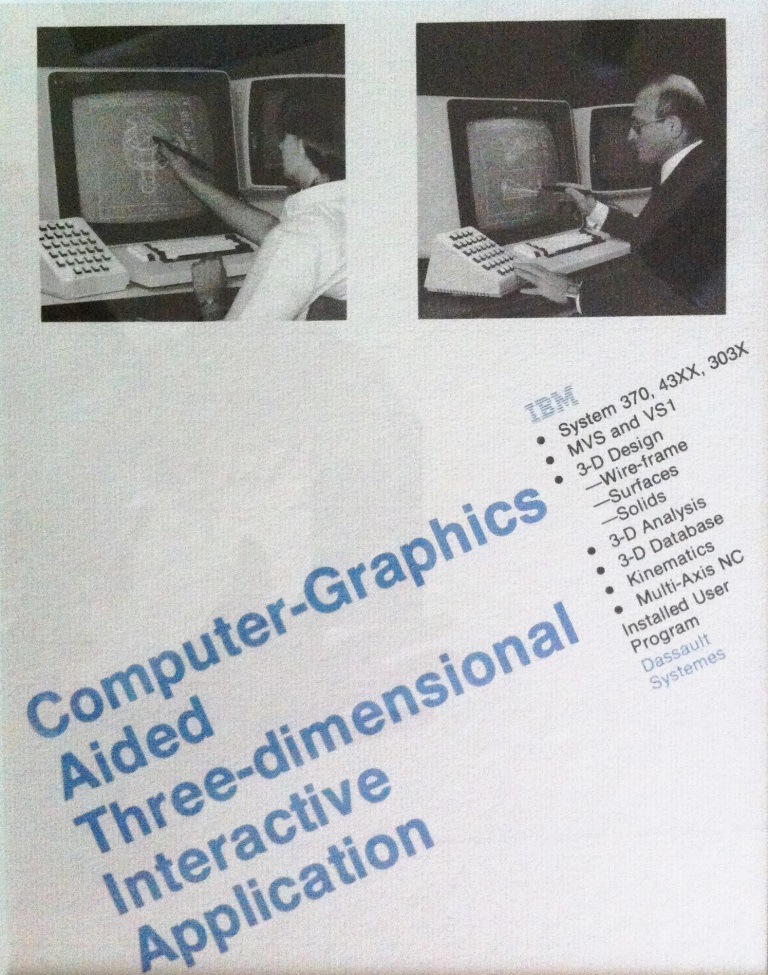
The first CATIA IBM flyer
15. How did the idea come about to establish a separate company? It seems clear to me that a very new company would not be able to organize an effective global marketing strategy of a very new product. Does it mean that the idea of a partnership with IBM came up simultaneously with the idea of establishing a company?
Yes. Without the partnership with IBM, we would not have established the DS company. It was the key decision factor. IBM was really like a dream for us: they had 80% of the hardware business at a worldwide level; they already had the experience and organization to sell CAD/CAM software with CADAM; and they were ready to invest significantly in human resources, because each CATIA sale generated ten times the hardware revenue for IBM. Revenue from each CATIA software sale was shared 50/50 between DS and IBM.
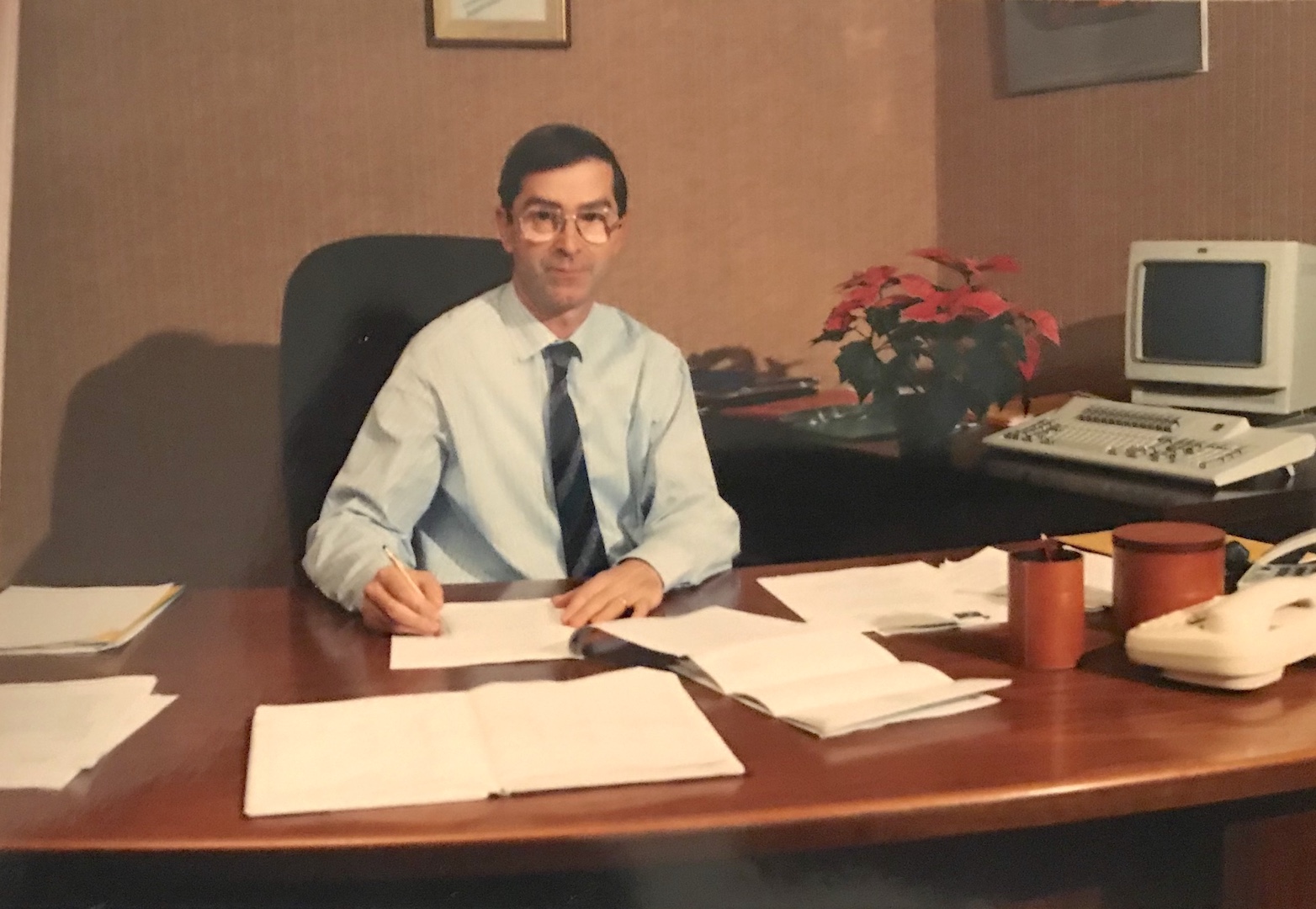
1988, Francis Bernard DS CEO
16. What were the biggest challenges for the company as it grew from 20 to 100 people, and then from 100 to 500 people?
The biggest challenges were to hire, train, and manage people according to six macro-processes that we decided to implement:
- PLAN: Vision and strategy definition and optimization
- DEFINE: Product management to address all markets (aero, auto, and so on)
- IMPLEMENT: Product development using hardware and software of the time
- SELL: Marketing and sales in close cooperation with IBM
- TEAM: Ecosystem management with technical partners and IBM
- CUSTOMER SERVICE: Customer loyalty through a strong maintenance process with IBM
We never faced a financial threat because revenues grew quite well and so we were profitable from the beginning.
17. Did you invent the company’s management processes, or did you adopt them from Dassault Aviation, or use some other management practices, perhaps brought in by consultants from IBM?
At the end of the 1980s, when we were more than 200 people, we contracted with consultants specialized in human resources management (not from IBM), to help us implement a clear company vision, along with a strategy (both technical and commercial) to implement the vision, and an execution system to execute the strategy and motivate our people.
On the other hand, we learned from IBM how to manage the software maintenance organization and process, as well as the definition of the pricing policy.
18. Obviously, the marketing power of IBM has very much helped you to gain customers such as Honda, Mercedes, BMW, and Boeing. However, it is clear that it involves a great deal of effort to convince these kinds of customers. Did demonstrations of CATIA speak for itself, or did you have more personal methods of convincing major customers? Could you give us one or two example?
IBM was in fact not involved with the very first customers, as I explained above. I got personally in touch and met the executives in charge of CAD/CAM at Honda, Mercedes, and BMW to present and demonstrate CATIA. The quality of these discussions generated the conviction at DA that CATIA had good business potential.
This generated a lot of motivation for my team and me, and it was a catalyst to convince IBM that we could be a good partner for selling more computers! These three customers (and a few others, such as Grumman Aerospace in USA and SAFRAN in France) were direct customers to DS and became IBM customers only a few years later.
Boeing is a different story. This was a very long battle to win, because my biggest competitor was an internally developed 3D CAD software package. And here the power and credibility of IBM together with our experience in airplane design at DA was essential.
I remember a question from the Boeing CEO when I met him in Seattle: “Please tell us how we can design an airplane in 3D,” and then his comment when he decided for CATIA in 1986: “I selected CATIA because I am confident in you, but I buy it from IBM because I cannot take the risk in implementing a major business transformation with too small a partner.”
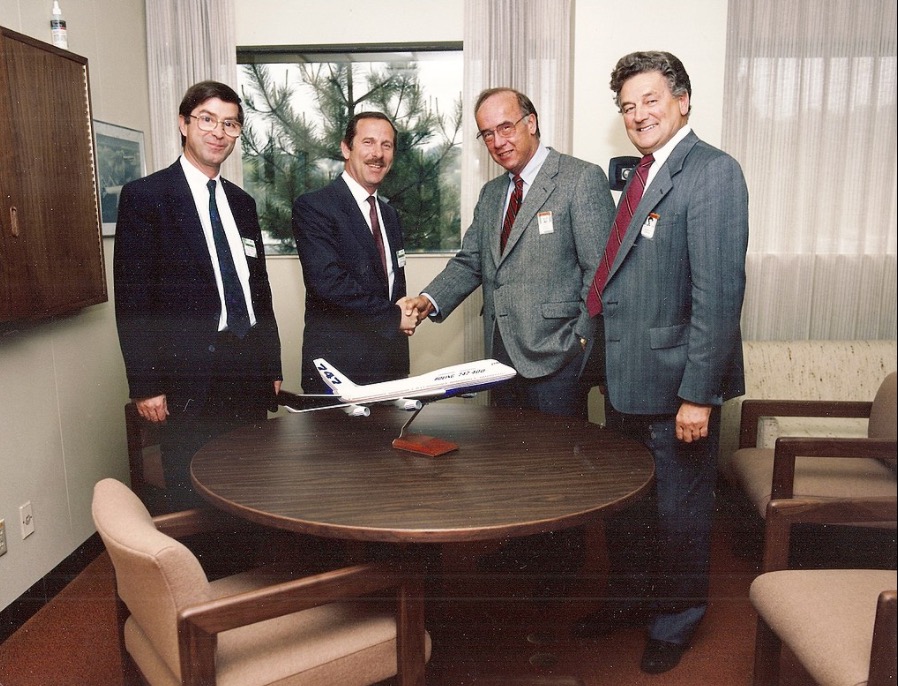
Francis Bernard et Charles Edelstenne with Boeing Group Directors
19. Doubtless, major (and not only major) customers were formulating initial requirements (at least for functions), and after they began using CATIA there were probably a lot of additional customer requests. How did you manage the balance between the need to satisfy customers and your own vision of the optimal (with respect to business) development of the software?
This is called “product management.” The process of product management is to collect and analyze all of the requirements generated by customers and prospects, to look at the competition, to support the development of IT, and to invent opportunities that are not yet visible to the market.
These inputs are the source of new deliveries of functions, based on the optimization of the revenue potential. As a matter of fact, product management is measured by success on the market.
At DS, each new software delivery is identified by a version number and a release number, VxRy. A new version number means that significant improvements were implemented in the structure of the software, most times to support major hardware developments, which makes it impossible to be fully compatible with the previous version.
Of course, tools are delivered to migrate the data from one version to the next. We announce a new version every five to ten years to support changes in hardware, from mainframes to Unix workstations and then to PCs.
By contrast, a new release of a given version is always fully compatible with the previous release. In other words, V5R8 is fully compatible with V5R7.
To manage the release process properly and to generate confidence in the sales team as well as from customers, it is essential to be time-driven. Therefore we delivered a new release around May and October each year.
It happens that a customer requests an enhancement that is not planned for a future release. Or our development takes too long for a customer. In such cases, we enter into a negotiation. Should the enhancement request have sufficient business potential, we may accelerate its development and require the customer to fund up to 50% of the development cost, with DS keeping full ownership rights of the enhancement developed.
If the enhancement does not have sufficient business potential (usually because it is specific to the customer), then we may develop the enhancement under a standard service contract funded 100% by the customer, who keeps the ownership rights to the enhancement.
20. Could you mention several people who were especially close to you during your CATIA and DS years, and who especially contributed to its success?
This is a difficult question, because everybody contributed in some way. But let me give you some names. The key members of the initial team at DA and at the beginning of DS were
- Dominique Calmels (visible in the picture with Marcel Dassault and me) was my Technical Director until 1990. (He passed away in 2017.)
- Didier Boucier, was a key technical specialist who was a major actor in the development of CATIA. (He retired in 2019.)
Then at DS there was
- Charles Edelstenne, DS board chairman, a clever businessman and one of the ten richest men in France. (He was also a former CEO of DA and is now president of Dassault Group.)
- Thibault de Tersant, who joined DS in 1986 as financial director, an excellent negotiator of acquisitions and support of large customers, as well as the management of pricing.
- Bernard Charlès, who joined DS in 1984, who became technical director in 1992, and then CEO in 1995. An ambitious leader with a very large ego.
I do not like Charles Edelstenne and Bernard Charlès from a human point of view, but I respect their significant contributions.
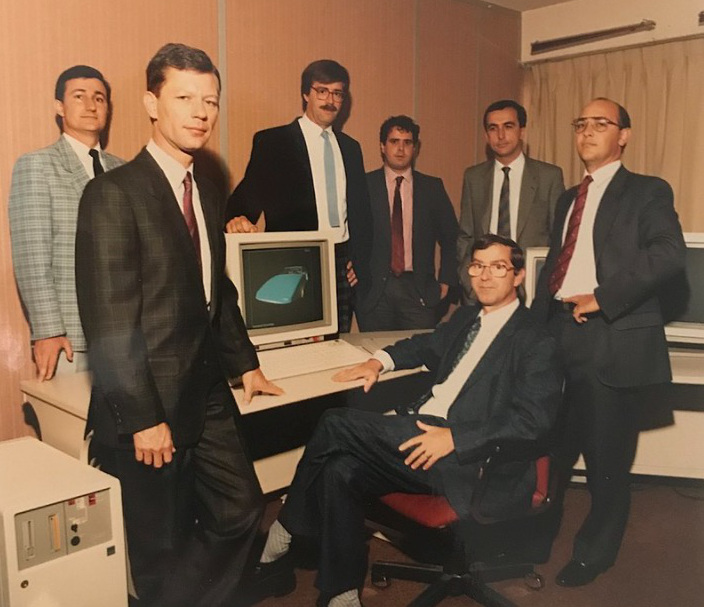
The Dassault Systèmes’ management in 1987: Francis Bernard, seated. Standing on the left, in the foreground, Dominique Calmels, at the back from left to right Bernard Charlès, Bernard Vermersh, Bruno Latchague, Philippe Forestier, Jean-Michel Morin
21. What are some key reasons for the success of DS
Let me give you a high-level summary:
- To be at the right place at the right time. This was the luck or the opportunity that we realized only years later, in that we took advantage of the IT revolution, the Cold War, Dassault Aviation, then globalization.
- To invent a major transformation with a long-term vision: “3D for all.” This was more than just inventing a gadget; it was the 2D-to-3D revolution thanks to IT.
- To make the right strategic decisions: the creation of a Dassault Systèmes independent of Dassault Aviation; the IBM partnership; the strong ecosystem of partners; partnerships with customers; and well-targeted acquisitions.
- To set up a robust management and execution system.
22. What are five most important milestones during your time at DA and DS?
This is a difficult question to answer, because there were dozens of important events. Here are five:
- 1967: My decision to join the aerodynamics department where the IT was initiated.
- 1968: My first CAD software, which created and smoothed curves, which became the part of the initial CATIA ten years later.
- 1977: The start of CATIA development.
- 1981: The launch of DS’s partnership with IBM.
- 1986: Landing Boeing as a customer.
23. The second decade of the 21st century has just passed. What do you consider to be the most interesting CAD trend, event, or story you observed during the decade?
I am not very much involved anymore, but I do see two major trends:
- The development of the IT platform on the cloud.
- The beginning of the implementation of PLM concepts in the medical domain: a numerical definition of the human body; analysis and simulation of its functions; maintenance and correction of deficiencies; and so on.
24.Do you agree that CAD has become less important in the contemporary IT world? Perhaps there are not enough ambitious challenges for CAD to address now?
I believe that it is like a concept of layers: more and more, CAD will become a de facto set of basic functions. Applications using these basic functions will be the visible part of a system.
25. The role of AI in CAD software is still quite limited, especially when compared to video processing and recognition and other areas. Do you expect a breakthrough here?
Yes. As I briefly described earlier, CAD may become an invisible layer below the AI layer.
26. What do you think about cloud-based CAD modeling? Will it replace traditional CAD on the desktop, or it will remain a niche solution for students and small businesses?
I believe that the cloud is just a new platform, making it easier to integrate and to communicate. It will probably not replace, but become a complementary option for most customers.
27. Sometimes, it seems to me that MCAD in its classic meaning (for manufacturing) is to some extent already exhausted. It is very effective, but any great new thing can hardly be done. If so, there could be two ways in particular for progress in business and technology: (1) CAD + real artificial intelligence, and (2) expansion of technology to new domains, such as medicine and finance. What do you think of this?
I addressed this in earlier questions. Yes, AI will become a major part of the future. Yes, new domains like medicine will be addressed; DS acquired recently Medidata in USA to go in such a direction. Finance, I am not sure because it is not at all related to shapes and physical/chemical simulations and it is already addressed by CRM and ERP applications.
And never forget: it is basically impossible to predict a development in technology more than ten years in advance. I like the quote from Henri Ford (1863-1947): “If I'd asked customers what they wanted, they would have said 'a faster horse'.”
28. How did it come about that you became the founder and first manager of DS Russia? Was it due to your own interest? How do you estimate the results of your work in Russia?
I left my CEO position to Bernard Charlès in 1995, because I wanted to focus my energy on new markets that could be addressed by industry (mainly shipbuilding) and by geography, mainly Russia, Israel, China, India, Turkey, Indonesia, and South Africa.
Addressing Russia: it is a prestigious country, with a long history with France, and so for me it was like a gift. I made the decision. I hired young Russian-speaking French businessman Laurent Valroff in 2005 to become the head of our subsidiary in Moscow.
Please look at the attachment “Interview with Francis Bernard, President of Dassault Systemes Russia Corp., CAD/CAM/CAE Observer #4(22)/2005” (pdf)

February 2005, Moscow. Kick-off of Dassault Systemes Russia
29. What are the criteria for a CEO to quit the position? Is it mostly due to the opinion of shareholders? Age? A reasonable limitation for the time in the position? The person’s own feelings, maybe from exhaustion of the mission? What do you think is the difference in success and time limitations for keeping a top position as the CEO of a company and the president of a country?
Any CEO will be replaced, because he is retiring, or he is not productive enough, or he is in conflict with the shareholders or the employees, or he wants to quit for another position, or ultimately he dies. The question is to manage this process with no negative impact, and, if possible, a positive impact on the company, the employees, and the shareholders.
In my case, there had been a kind of agreement between Charles Edelstenne (board director), Bernard Charlès (technical director), and myself as CEO. Bernard Charlès was younger than me by 18 years, more ambitious (a killer), and more motivated than me to manage the exponential growth of the company.
I am not an ambitious killer; I am just passionate to work for and with people and customers all around the world. Charles Edelstenne arbitrated an agreement to transfer the CEO position to Bernard Charlès and to let me address new markets at the time and emerging countries. (See my earlier response on Russia). The process went quickly and smoothly, without any frustration or trouble.
The success criteria for a CEO is to meet the company’s objectives in terms of revenues; for the president of a country, it is to be re-elected.
The limitation for a CEO is the company’s performance; for a president, it is the support of the chambers and the electors. Of course, I mean this for a democracy that is like a company in which the customers are the electors! The more a state looks like a dictatorship, the more it looks like a company with no customers!
30. As an advisor and a member of the board, you have contacts with a lot of companies and startups. Which are the most interesting to you?
I have contacts only with startups in the digital domain with B2B [business to business] solutions. This is related to my past experience with DS, CAD, and PLM. But I must recognize that DS was not a startup but outsourced from DA. As long as we had the DA reference, a good motivated team, and the IBM partnership, the risk was limited.
When I look at a startup, I verify the vision (a statement with a clear objective) and the product (what is the value to the customer, is it a must-have solution?) with the early customers, the competition, the team (is the leader heading a reasonable management structure?), and the ecosystem. In our complex environment, a startup without technical and/or sales partners has nearly no chance to succeed.
31. Do you still have contact with people in today’s DS? And with people from DS prior to 1995?
Not anymore. I just have friendly contacts with many former and current DS people. Some of them have created their own startups.
32. Could you mention several persons (from any period and domain) you consider outstanding, the most interesting, and have the most impression on your life?
There are the people I listed in my earlier response. Now, in terms of human relationship quality, I would select Didier Bourcier. And I also have a very high respect for two people from IBM:
- Dave Brock (dabrock@excellenc.com) in California USA. During the 80s he was the IBM sales director for DS products in USA. He played a major role to win Boeing.
- Raoul Van Engershoven (raoulvanengelshoven@gmail.com). During the 90s he was the IBM sales director for the DS products in Asia. He played a major role to make us number one in China, Japan, Korea, and India. Also a great man with humanity.
33. Could you tell something about your family? Who is your wife, where did you acquainted?
My wife is Solange. We met in Paris in 1964 and got married in 1965. She worked her entire professional life in the Ministry of Labour, Delegation of Training and Employment programs. Her parents were born in eastern Poland, when before the First World War it was part of Russia. They immigrated to France in 1925 and became French citizens. This is one of the reasons we are so interested in Russian culture.
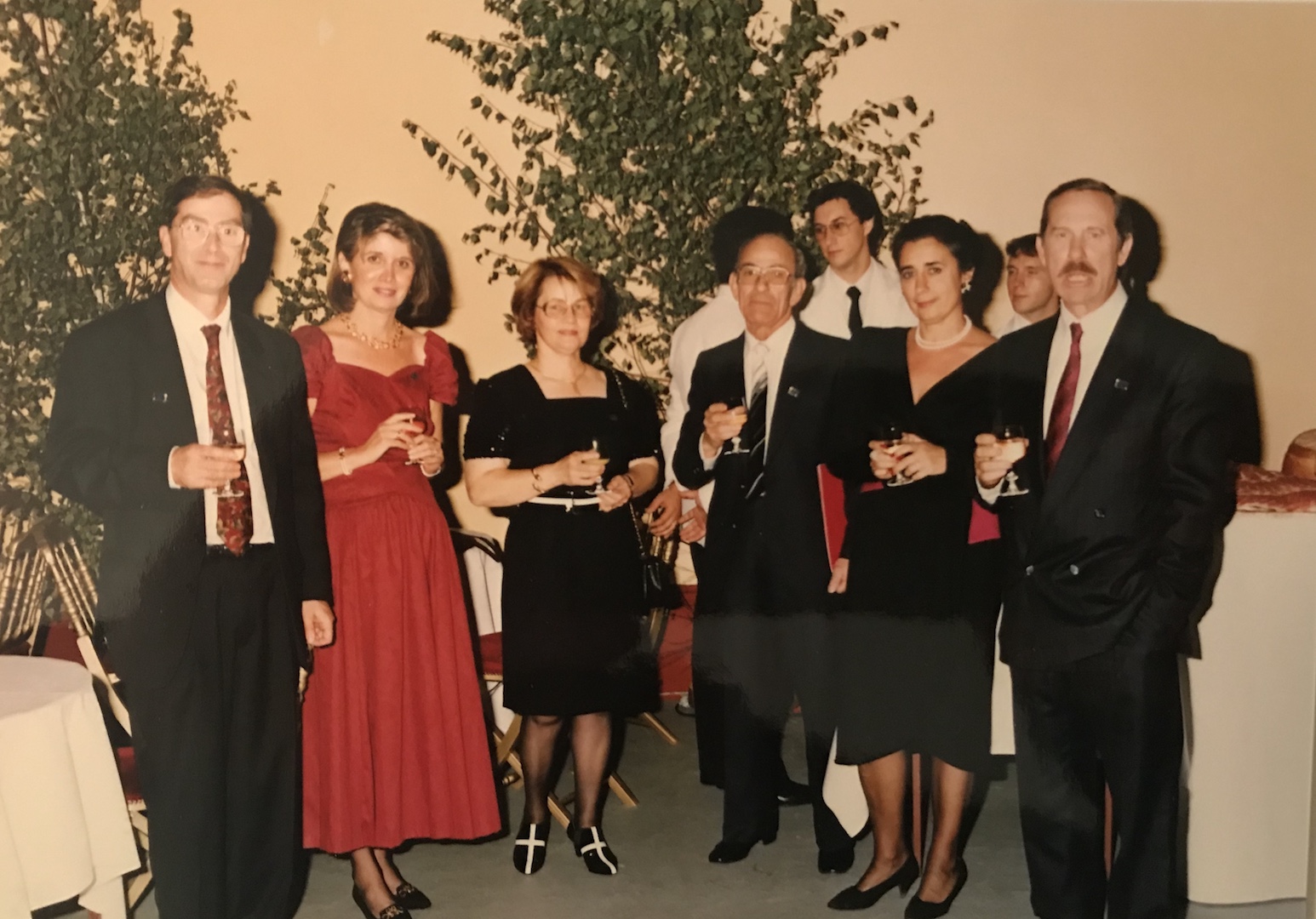
1991. Ñelebrating with all the DS people the 10th anniversary of the company. Francis Bernard, his wife Solange (on the left), Mrs & Mr Douvry (in the center) and Charles Edelstenne and his wife (on the right). Pierre Douvry was the financial assistant to Charles Edelstenne in DA.
34. How many children and grandchildren do you have? Did your career impact their choice of profession?
We have two married daughters living in Paris. Corinne is a business manager at Microsoft, and Virginie is a business lawyer. I influenced Corinne to start with IBM France when she left university. Then after a few years, she was pursued by Microsoft. And we have five grandchildren, from 18 to 23 years old.
35. How do you spend your free time? In the countryside? Which books have your read recently? Movies? Which foreign countries did you visit in the last few years, before the pandemic. Do you have some countries you prefer besides France?
We live in Paris, and have a house on the Atlantic Ocean and an apartment in the Alps where we stay several weeks each year. We love travelling by plane or on cruise ships. Our last cruise was in February 2020, just before the pandemic, along the coast of Panama and Costa Rica, south west of the USA.
And we plan to cruise from Copenhagen to Stockholm in May 2021, with a three-day stop in St Petersburg. But unfortunately, the cruise will most likely be delayed because of the pandemic.
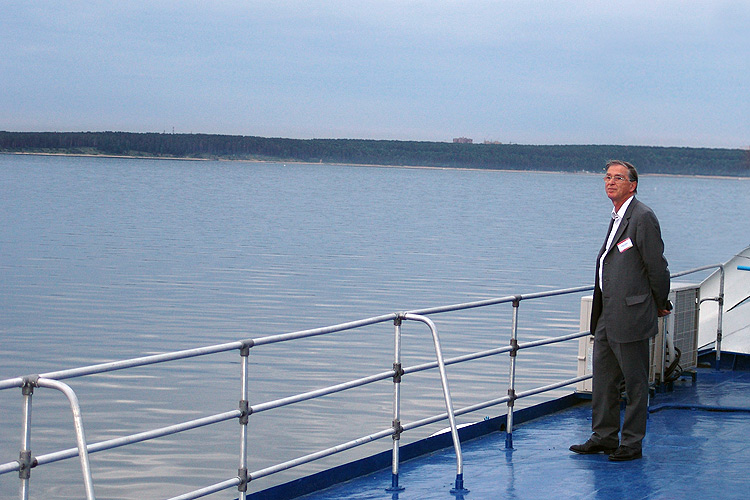
Novosibirsk, Ob River, 2008.
See also:
Permanent link :: http://isicad.net/articles.php?article_num=21729

|